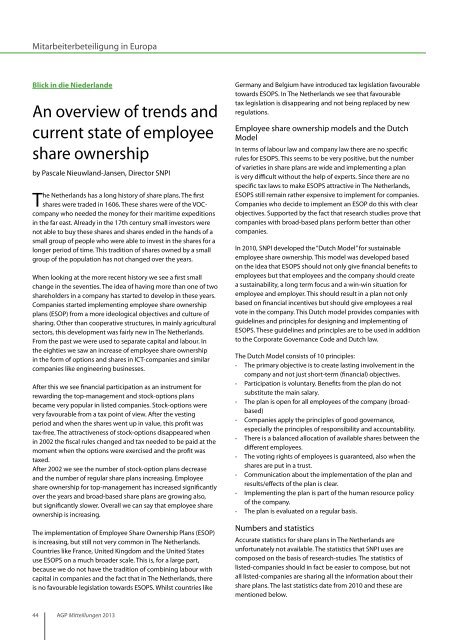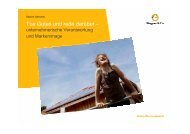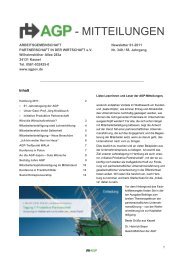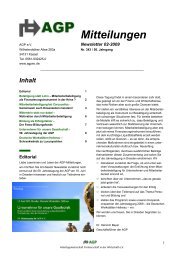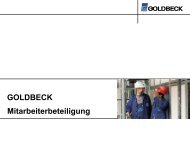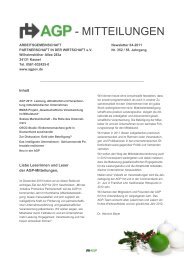Heft Nr. 354 / 60. Jahrgang - AGP
Heft Nr. 354 / 60. Jahrgang - AGP
Heft Nr. 354 / 60. Jahrgang - AGP
Erfolgreiche ePaper selbst erstellen
Machen Sie aus Ihren PDF Publikationen ein blätterbares Flipbook mit unserer einzigartigen Google optimierten e-Paper Software.
Mitarbeiterbeteiligung in EuropaBlick in die NiederlandeAn overview of trends andcurrent state of employeeshare ownershipby Pascale Nieuwland-Jansen, Director SNPIThe Netherlands has a long history of share plans. The firstshares were traded in 1606. These shares were of the VOCcompanywho needed the money for their maritime expeditionsin the far east. Already in the 17th century small investors werenot able to buy these shares and shares ended in the hands of asmall group of people who were able to invest in the shares for alonger period of time. This tradition of shares owned by a smallgroup of the population has not changed over the years.When looking at the more recent history we see a first smallchange in the seventies. The idea of having more than one of twoshareholders in a company has started to develop in these years.Companies started implementing employee share ownershipplans (ESOP) from a more ideological objectives and culture ofsharing. Other than cooperative structures, in mainly agriculturalsectors, this development was fairly new in The Netherlands.From the past we were used to separate capital and labour. Inthe eighties we saw an increase of employee share ownershipin the form of options and shares in ICT-companies and similarcompanies like engineering businesses.After this we see financial participation as an instrument forrewarding the top-management and stock-options plansbecame very popular in listed companies. Stock-options werevery favourable from a tax point of view. After the vestingperiod and when the shares went up in value, this profit wastax-free. The attractiveness of stock-options disappeared whenin 2002 the fiscal rules changed and tax needed to be paid at themoment when the options were exercised and the profit wastaxed.After 2002 we see the number of stock-option plans decreaseand the number of regular share plans increasing. Employeeshare ownership for top-management has increased significantlyover the years and broad-based share plans are growing also,but significantly slower. Overall we can say that employee shareownership is increasing.The implementation of Employee Share Ownership Plans (ESOP)is increasing, but still not very common in The Netherlands.Countries like France, United Kingdom and the United Statesuse ESOPS on a much broader scale. This is, for a large part,because we do not have the tradition of combining labour withcapital in companies and the fact that in The Netherlands, thereis no favourable legislation towards ESOPS. Whilst countries likeGermany and Belgium have introduced tax legislation favourabletowards ESOPS. In The Netherlands we see that favourabletax legislation is disappearing and not being replaced by newregulations.Employee share ownership models and the DutchModelIn terms of labour law and company law there are no specificrules for ESOPS. This seems to be very positive, but the numberof varieties in share plans are wide and implementing a planis very difficult without the help of experts. Since there are nospecific tax laws to make ESOPS attractive in The Netherlands,ESOPS still remain rather expensive to implement for companies.Companies who decide to implement an ESOP do this with clearobjectives. Supported by the fact that research studies prove thatcompanies with broad-based plans perform better than othercompanies.In 2010, SNPI developed the “Dutch Model” for sustainableemployee share ownership. This model was developed basedon the idea that ESOPS should not only give financial benefits toemployees but that employees and the company should createa sustainability, a long term focus and a win-win situation foremployee and employer. This should result in a plan not onlybased on financial incentives but should give employees a realvote in the company. This Dutch model provides companies withguidelines and principles for designing and implementing ofESOPS. These guidelines and principles are to be used in additionto the Corporate Governance Code and Dutch law.The Dutch Model consists of 10 principles:• The primary objective is to create lasting involvement in thecompany and not just short-term (financial) objectives.• Participation is voluntary. Benefits from the plan do notsubstitute the main salary.• The plan is open for all employees of the company (broadbased)• Companies apply the principles of good governance,especially the principles of responsibility and accountability.• There is a balanced allocation of available shares between thedifferent employees.• The voting rights of employees is guaranteed, also when theshares are put in a trust.• Communication about the implementation of the plan andresults/effects of the plan is clear.• Implementing the plan is part of the human resource policyof the company.• The plan is evaluated on a regular basis.Numbers and statisticsAccurate statistics for share plans in The Netherlands areunfortunately not available. The statistics that SNPI uses arecomposed on the basis of research-studies. The statistics oflisted-companies should in fact be easier to compose, but notall listed-companies are sharing all the information about theirshare plans. The last statistics date from 2010 and these arementioned below.44 <strong>AGP</strong> Mitteillungen 2013


